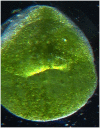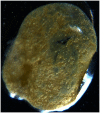Magnetic and electric field accelerate Phytoextraction of copper Lemna minor duckweed
- PMID: 34347844
- PMCID: PMC8336833
- DOI: 10.1371/journal.pone.0255512
Magnetic and electric field accelerate Phytoextraction of copper Lemna minor duckweed
Abstract
In accordance with the opinion of the World Health Organization and the World Water Council the development of effective technologies for the treatment of wastewater from heavy metals for their discharge into water bodies or reuse is an urgent task nowadays. Phytoremediation biotechnologies is the most environmentally friendly and cheapest way of the treatment of wastewater, suitable for sustainable development principals. The main disadvantage of the phytoremediation is the slow speed of the process. A method for accelerating the process of phytoremediation by the combined effect of magnetic and weak electric fields is proposed. The purpose of this study is to determine the values of the parameters of the magnetic and weak electric fields that are most suitable for extracting cuprum ions from wastewater using the higher aqua plants (Lemna minor). A corresponding technological process based on the results of the study is proposed. The results have shown that the removal of copper cations from sulfate solutions effectively occurs in the initial period of time (1-5 hours) under the influence of a magnetic field with an intensity of H = 2 kA/m. Under the combined influence of an electrical current with density j = 240 μA/cm2 and a magnetic field (H = 2 kA/m) the highest rate of copper extraction by duckweed leaves is achieved. Under these conditions, the greatest growth and development of plant leaves occurs. The paper presents the results of determining of the parameters of the electrochemical release from the eluate of the spent phytomass of duckweed. It has been determined that the release of metal occurs at E = 0.32 V. An original scheme for wastewater treatment from copper with subsequent separation of copper from the spent phytomass of duckweed is proposed. In general, the presented results are a scientific justification of wastewater treatment technologies and a contribution to resolving the crisis in the field of fresh water supply. An important contribution in the circular economy is a technology recommendation proposed for recovering copper from duckweed after wastewater treatment.
Conflict of interest statement
The authors have declared that no competing interests exist.
Figures









Similar articles
-
Phytoremediation Potential of Duckweed (Lemna minor L.) On Steel Wastewater.Int J Phytoremediation. 2015;17(1-6):589-96. doi: 10.1080/15226514.2014.950410. Int J Phytoremediation. 2015. PMID: 25192438
-
Removal of estrone, 17alpha-ethinylestradiol, and 17beta-estradiol in algae and duckweed-based wastewater treatment systems.Environ Sci Pollut Res Int. 2010 May;17(4):824-33. doi: 10.1007/s11356-010-0301-7. Epub 2010 Mar 7. Environ Sci Pollut Res Int. 2010. PMID: 20213308
-
Heavy metals/-metalloids (As) phytoremediation with Landoltia punctata and Lemna sp. (duckweeds): coupling with biorefinery prospects for sustainable phytotechnologies.Environ Sci Pollut Res Int. 2024 Mar;31(11):16216-16240. doi: 10.1007/s11356-024-32177-5. Epub 2024 Feb 9. Environ Sci Pollut Res Int. 2024. PMID: 38334920 Review.
-
The enzymatic and antioxidative stress response of Lemna minor to copper and a chloroacetamide herbicide.Environ Sci Pollut Res Int. 2015 Dec;22(23):18495-507. doi: 10.1007/s11356-015-5139-6. Epub 2015 Aug 20. Environ Sci Pollut Res Int. 2015. PMID: 26286797
-
Phytoremediation of toxic chemicals in aquatic environment with special emphasis on duckweed mediated approaches.Int J Phytoremediation. 2023;25(13):1699-1713. doi: 10.1080/15226514.2023.2188423. Epub 2023 Mar 20. Int J Phytoremediation. 2023. PMID: 36941761 Review.
References
-
- Katyaini S, Barua A. Water policy at science–policy interface–challenges and opportunities for India. Water Policy. 2016; 18(2): 288–303. doi: 10.2166/wp.2015.086 - DOI
-
- World Health Organization. Progress on household drinking water, sanitation and hygiene 2000–2017: special focus on inequalities. 2019; https://www.who.int/water_sanitation_health/publications/jmp-report-2019....
-
- Klimes M, Michel D, Yaari E, Restiani P. Water diplomacy: The intersect of science, policy and practice. J Hydrol. 2019; 575: 1362–1370. doi: 10.1016/j.jhydrol.2019.02.049 - DOI
-
- Moghaddam VK, Changani F, Mohammadi A, Hadei M, Ashabi R, et al.. Sustainable development of water resources based on wastewater reuse and upgrading of treatment plants: a review in the Middle East. Desalin Water Treat. 2017; 65: 463–473.
Publication types
MeSH terms
Substances
LinkOut - more resources
Full Text Sources

